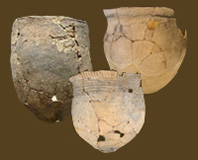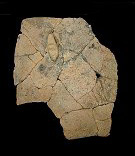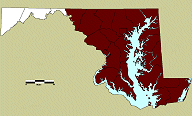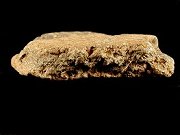Marcey Creek
Defining Attributes
Marcey Creek is an Early Woodland ware characterized
by crushed steatite temper, rough and unevenly smoothed exterior
and interior surfaces. Vessels have a flat net- or fabric-impressed
base with a protruding heel and vertical walls.
Chronology
Stratigraphic sequences and radiometric dating
indicate that Marcey Creek dates from ca. 1000 B.C. – 750
B.C. (Stewart 1982:74);1200 B.C. – 800 B.C. (Egloff and Potter
1982:97).
Distribution
Marcey Creek is found throughout the Coastal
Plain and Piedmont Regions, from Delaware south to the James River
in Virginia.
Description
Paste/Temper
The paste ranges from coarse to fine and smooth, depending on
the size of the temper particles. The clay is fine-to-medium grained,
compact, and cohesive. The temper consists of coarse-to-fine crushed
steatite that varies from very fine – 10s mm in diameter, and
makes up 25 – 50% of paste. The steatite gives the sherds a soapy
or greasy feel not otherwise a property of the clay. Marcey Creek
is very soft, with a Moh’s hardness of 1.5 – 2.0. Color
ranges from an oxidized dull gray, through buff and tan, to rose
and reddish brown. Stephenson et al. (1963:91) noted, however,
that buffs and reddish - tans are dominant at the Accokeek Creek
site (18PR8).
Surface Treatment
Marcey Creek is smoothed from the lip to the base, but exhibits
a wavy or lumpy appearance, and is rough to the touch. The surface
is very uneven and irregular, with lumps of temper protruding
through the paste. The flat base sherds show impressions of a
coarse, open weave fabric or net. Interiors are smoothed or plain.
Decoration
The only decorations recorded by Stephenson et al. (1963:91) were
"occasional lip nicking." Incising has been observed
on sherds in rare occasions, and even more rarely the vessels
exhibit patterns on rim exteriors (Wall et al. 2000). A few incised
sherds from the W.A. Walker Farm, Selden Island are in the Smithsonian
collections.
Morphology
Marcey Creek is a hand-modeled ceramic with flat-bottomed bases
and straight slab-constructed walls. Some vessels possibly coil-constructed
on a flat base (Stephenson et al.1963:91, Egloff and Potter 1982:95).
Marcey Creek vessels were apparently copied from steatite bowls
(Wise 1975:21), with oval to cylindrical bodies tending towards
the globular, straight sides, and lug handles attached to the
rim area 20 mm – 40 mm below the lip.
Bases are flat with protruding heels, and range from 9 mm – 15
mm in thickness. Basal sherds are heavy and unevenly finished.
All basal sherds recovered from the Marcey Creek site exhibit
impressions of a coarsely woven mat on the exterior (Manson 1948:225)
and this trait is found throughout this pottery’s distribution.
Rims are vertical to slightly inverted. Lips are usually thinner
than the body and are rounded or slightly wedge-shaped.
Vessel wall thickness range from 7 mm – 14 mm. Vessels are medium
sized, with sherds and small sections of pots suggesting diameters
of 15 cm – 28 cm, and depths of 10 cm – 20 cm.
Defined in the Literature
Carl Manson (1948:223) first defined Marcey Creek from pottery
found at the Marcey Creek site, located on the banks of the Potomac
River in Arlington County, Virginia, across from Washington D.C.
He identified two wares, Marcey Creek Plain and Marcey Creek Cord
Marked, from the site. Manson noted, however, that Marcey Creek
Cord Marked differs in temper (clay and crushed lithic materials
other than steatite) and manufacturing technique from Marcey Creek
Plain. In 1955, Clifford Evans combined both wares with the Selden
Island ware defined by Richard Slattery to create the Marcey Creek
Series. Stephenson et al. (1963) later refined the definition
of Marcey Creek Plain using sherds found at the Accokeek Creek
site (18PR8), in Prince George’s County, Maryland.
Type Site
Marcey Creek site
| Radiocarbon Dates |
| Date |
Sample
# |
Site |
Feature |
Reference |
2900 + 95;
B.C. 950 |
I-5091 |
Monocacy
(18FR100) |
Zone
5 |
Ayers
1972 |
2495 + 95;
B.C. 545 |
I-5090 |
Monocacy
(18FR100) |
Zone
5 |
Ayers
1972 |
References:
Ayers
1972; Egloff
& Potter 1982; Manson
1948; Stephenson
et al. 1963; Wise
1975 |






